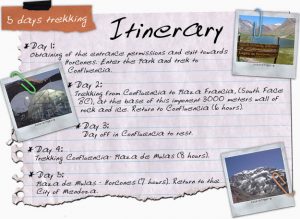Project-Based Learning Method 1: Foreign Language Travel Guide

The world is becoming as diverse as ever before and it this awareness has created a need to understand from one another’s differences and multicultural backgrounds. Our inter-connectivity doesn’t just exist online, however, as traveling outside of one’s home country isn’t as uncommon as it once was. This increases the importance to understand different languages to communicate properly, thus when traveling it’s always efficient to carry around an organized travel guide.
For my project-based learning idea, students would be required to create a short 1-2 page travel itinerary to use as though they were traveling abroad to a foreign country in which the language being taught in the classroom is a common language there. Students would be required to section off their travel guide with:
- A day’s activities planned, including what times their flights are, places they’d like to see, restaurants they’d like to visit, and other attractions worth mentioning to the student in that target language using targeted vocabulary words in a ‘travelling abroad’ unit taught
- A variety of common questions or phrases in that foreign language that can be used at an airport and outside of an airport. For example: “What time does flight 421 take off?” or “Where’s the nearest bathroom?”
- A short section of how to convert from USD to that country’s respected currency
- Common foods, traditions, or other miscellaneous ideas about that country that might be critical to keep in mind while traveling

This project-based learning activity encourages students to get creative with things that would seem most useful to them if they were ever in a position to travel to that country. To encourage student-learning, it would be allowed for students to collaborate with one another on how to organize or phrase their ideas into their final project, however each student would need to individually design their own travel guide to turn in.
PBL components would be highlighted in the following ways:
 Real-World Connection: Globalization has allowed us to become more advanced with the way we move and our ways of communication should follow. With populations on the rise and over 6,000 spoken languages worldwide today, understanding is critical to how we see one another.
Real-World Connection: Globalization has allowed us to become more advanced with the way we move and our ways of communication should follow. With populations on the rise and over 6,000 spoken languages worldwide today, understanding is critical to how we see one another.
Core Learning: Students have the opportunity to gain knowledge about a country’s background, simple yet critical phrases or words to use while traveling, and promoting creativity while exercising their language skills
Collaboration: Students perform this project individually, however they are encouraged to branch off their ideas and to ask questions with their peers to better understand how to approach such a project
Student-Driven: Students are given a level of freedom here to pick a place to travel and areas they’d like to visit, while also allowing them to include ideas into their travel guides they deem would fit the project as if it were to actually take place
Multifaceted Assessment: Following the end of the project, students would be given a short ‘I can…’ assessment in which students place check marks next to learning goals they should be able to reach once the project is over. Such statements can include:
- I can…use vocabulary words from this unit when travelling abroad
- I can…compare my culture to the target culture
- I can…use the language to present information to an audience
- I can…use the language to engage in interpersonal communication
Such a project allows for students to be engaged in what they are learning because it relates to real-world problems in which they might be faced with a similar situation while promoting student freedom and creativity to learn within a developed curriculum.

Lesson Plan:
- Introduce a ‘traveling’ unit to your world language class in which certain and critical vocabulary words are highlighted for students to use/remember
- Allow for students to think of a part of the world in which that language is commonly spoken and would be interesting for that student to travel to before introducing the project
- Pass out a list of important/required information needed for a travel guide along with any additional ideas that students might want to add themselves (as outlined above)
- Allow students time in class to research what they’d like to put on their travel guide/ask questions and collaborate with other students. Recommended time would be 1-2 days in class, although time outside of class would be permitted
- Allow students to come in the next day with their printed information/travel guide to turn in
- Have students perform an ‘I can…’ statement assessment sheet to understand where students feel after creating their projects
For more information on PBL, this video explains it in further detail. I also referred to this website that gave me some ideas of projects I could use (before later revising it to fit how I would use it in my own classroom) and finally this website that specializes in world languages that gave some examples of some ‘I can’ statements to use in the multifaceted assessment.
